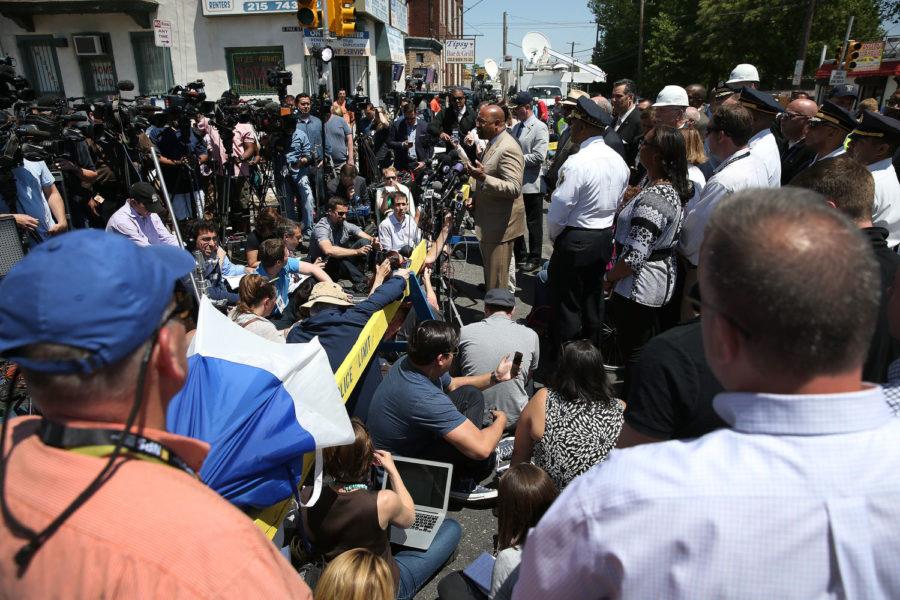Amtrak derailment mystery: Train sped up in final minute, NTSB says
May 14, 2015
An Amtrak passenger train that flew off the tracks at high speed, killing eight people, steadily and rapidly accelerated in the 65 seconds before entering a curve, investigators said Thursday as the mystery behind the engineer’s actions deepened.
At a news conference two days after the crash, National Transportation Safety Board member Robert Sumwalt said investigators did not yet know the reason for the acceleration or whether it was done manually or automatically. But Sumwalt said the NTSB planned to meet with the engineer, Brandon Bostian, “in the next few days” to try to get his account of what happened Tuesday night.
“We look very much forward to the opportunity to interview him,” Sumwalt said of the 32-year-old New York-based engineer, whose actions in the locomotive of Amtrak’s Northwest Regional Train 188 have become the focus of the inquiry.
Advertisement
Earlier Thursday, the death toll rose to eight after a cadaver-sniffing dog found the body of a passenger in the tangled wreckage of the first passenger car. Heavy machinery had to be used to tear through the metal to retrieve the body.
“Eight deceased for this horrible tragedy,” Philadelphia Mayor Michael Nutter said as he announced the latest death.
Nutter has described Bostian’s actions as “reckless,” based on NTSB analysis of data recorders showing that the train was traveling 106 mph heading into a curve zoned for 50 mph. All seven passenger cars and the locomotive derailed about 9:21 p.m. as the train headed from Washington to New York City.
Sumwalt said the timeline of the acceleration came from a video camera trained on the tracks and positioned inside the cab where Bostian rode. The camera showed the time and the train’s speed.
Sixty-five seconds before impact, the train was “above 70 miles per hour,” Sumwalt said. That suggests the train was within the 80-mph speed limit on the straightaway leading to the curve.
But instead of slowing down to the curve’s 50-mph limit, the train went faster.
At 43 seconds before impact, its speed exceeded 80 mph, Sumwalt said. Thirty-one seconds before impact, it went above 90 mph. The train was traveling at more than 100 mph 16 seconds before the crash, he said.
Advertisement*
“Mere seconds into the turn,” Sumwalt said, the train tilted about 10 degrees to the right as the derailment began. “And then the recording went blank.”
Investigators have determined that the emergency braking system was activated a few seconds before the crash, but it was too late.
Bostian’s attorney, Robert Goggin, has said his client has “absolutely no recollection” of the crash or of deploying the emergency brake. Goggin told ABC’s “Good Morning America” on Thursday that Bostian suffered a concussion and other injuries, and had 15 staples in his head as well as stitches in his leg.
He was “knocked out” by the crash but recalls regaining consciousness, searching for his bag and calling 911 on his cellphone, Goggin said. He said Bostian told him that he did not have any medical issues and that he immediately consented to a police request to have his blood tested. The test turned up “no drinking, no drugs, no medical conditions, nothing,” the attorney said.
Goggin said Bostian’s cellphone was put away in his bag and was not turned on while he was operating the train, per Amtrak rules.
Even as investigators focused on Bostian and the train’s speed, officials pressed the need for an automated safety system known as positive train control, which they say could have prevented the disaster. The system is in operation in parts of Amtrak’s busy Northeast corridor, but not along the northbound stretch of track where the train derailed.
Amtrak President and Chief Executive Joseph H. Boardman pledged that the company would complete installing the system on its rail lines by Dec. 31, the deadline imposed by Congress.
“We will complete this by the end of the year,” he said. “I believe we will probably be the only railroad in the United States and in the Western Hemisphere that will have positive train control.”
Sumwalt said he was confident that if the system had been installed, the Tuesday crash would have been prevented. He also said that checks of the rails and of the train’s braking system had not turned up anything unusual.
The crash halted Amtrak service linking Washington to Boston. Boardman said he expected partial service to be back Monday and full service to resume Tuesday.
Advertisement








